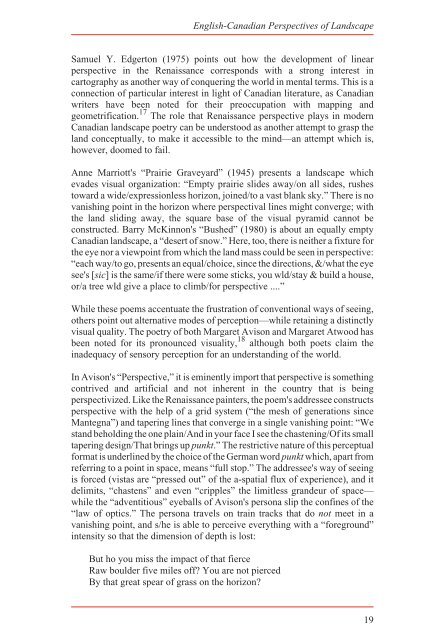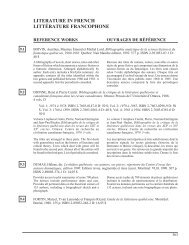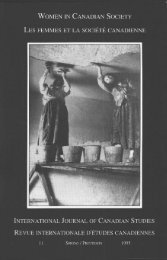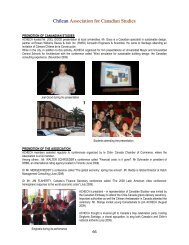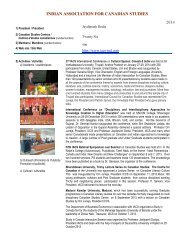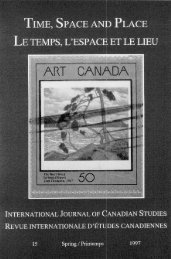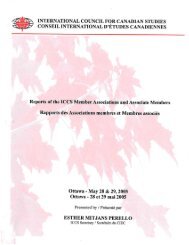Arts and Literature in Canada:Views from Abroad, Les arts et la ...
Arts and Literature in Canada:Views from Abroad, Les arts et la ...
Arts and Literature in Canada:Views from Abroad, Les arts et la ...
- No tags were found...
You also want an ePaper? Increase the reach of your titles
YUMPU automatically turns print PDFs into web optimized ePapers that Google loves.
English-Canadian Perspectives of L<strong>and</strong>scapeSamuel Y. Edgerton (1975) po<strong>in</strong>ts out how the development of l<strong>in</strong>earperspective <strong>in</strong> the Renaissance corresponds with a strong <strong>in</strong>terest <strong>in</strong>cartography as another way of conquer<strong>in</strong>g the world <strong>in</strong> mental terms. This is aconnection of particu<strong>la</strong>r <strong>in</strong>terest <strong>in</strong> light of Canadian literature, as Canadianwriters have been noted for their preoccupation with mapp<strong>in</strong>g <strong>and</strong>geom<strong>et</strong>rification. 17 The role that Renaissance perspective p<strong>la</strong>ys <strong>in</strong> modernCanadian l<strong>and</strong>scape po<strong>et</strong>ry can be understood as another attempt to grasp thel<strong>and</strong> conceptually, to make it accessible to the m<strong>in</strong>d—an attempt which is,however, doomed to fail.Anne Marriott's “Prairie Graveyard” (1945) presents a l<strong>and</strong>scape whichevades visual organization: “Empty prairie slides away/on all sides, rushestoward a wide/expressionless horizon, jo<strong>in</strong>ed/to a vast b<strong>la</strong>nk sky.” There is novanish<strong>in</strong>g po<strong>in</strong>t <strong>in</strong> the horizon where perspectival l<strong>in</strong>es might converge; withthe l<strong>and</strong> slid<strong>in</strong>g away, the square base of the visual pyramid cannot beconstructed. Barry McK<strong>in</strong>non's “Bushed” (1980) is about an equally emptyCanadian l<strong>and</strong>scape, a “desert of snow.” Here, too, there is neither a fixture forthe eye nor a viewpo<strong>in</strong>t <strong>from</strong> which the l<strong>and</strong> mass could be seen <strong>in</strong> perspective:“each way/to go, presents an equal/choice, s<strong>in</strong>ce the directions, &/what the eyesee's [sic] is the same/if there were some sticks, you wld/stay & build a house,or/a tree wld give a p<strong>la</strong>ce to climb/for perspective ....”While these poems accentuate the frustration of conventional ways of see<strong>in</strong>g,others po<strong>in</strong>t out alternative modes of perception—while r<strong>et</strong>a<strong>in</strong><strong>in</strong>g a dist<strong>in</strong>ctlyvisual quality. The po<strong>et</strong>ry of both Margar<strong>et</strong> Avison <strong>and</strong> Margar<strong>et</strong> Atwood hasbeen noted for its pronounced visuality, 18 although both po<strong>et</strong>s c<strong>la</strong>im the<strong>in</strong>adequacy of sensory perception for an underst<strong>and</strong><strong>in</strong>g of the world.In Avison's “Perspective,” it is em<strong>in</strong>ently import that perspective is som<strong>et</strong>h<strong>in</strong>gcontrived <strong>and</strong> artificial <strong>and</strong> not <strong>in</strong>herent <strong>in</strong> the country that is be<strong>in</strong>gperspectivized. Like the Renaissance pa<strong>in</strong>ters, the poem's addressee constructsperspective with the help of a grid system (“the mesh of generations s<strong>in</strong>ceMantegna”) <strong>and</strong> taper<strong>in</strong>g l<strong>in</strong>es that converge <strong>in</strong> a s<strong>in</strong>gle vanish<strong>in</strong>g po<strong>in</strong>t: “West<strong>and</strong> behold<strong>in</strong>g the one p<strong>la</strong><strong>in</strong>/And <strong>in</strong> your face I see the chasten<strong>in</strong>g/Of its smalltaper<strong>in</strong>g design/That br<strong>in</strong>gs up punkt.” The restrictive nature of this perceptualformat is underl<strong>in</strong>ed by the choice of the German word punkt which, apart <strong>from</strong>referr<strong>in</strong>g to a po<strong>in</strong>t <strong>in</strong> space, means “full stop.” The addressee's way of see<strong>in</strong>gis forced (vistas are “pressed out” of the a-spatial flux of experience), <strong>and</strong> itdelimits, “chastens” <strong>and</strong> even “cripples” the limitless gr<strong>and</strong>eur of space—while the “adventitious” eyeballs of Avison's persona slip the conf<strong>in</strong>es of the“<strong>la</strong>w of optics.” The persona travels on tra<strong>in</strong> tracks that do not me<strong>et</strong> <strong>in</strong> avanish<strong>in</strong>g po<strong>in</strong>t, <strong>and</strong> s/he is able to perceive everyth<strong>in</strong>g with a “foreground”<strong>in</strong>tensity so that the dimension of depth is lost:But ho you miss the impact of that fierceRaw boulder five miles off? You are not piercedBy that great spear of grass on the horizon?19


